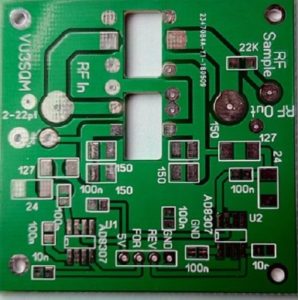Finding the resonant frequency of a resonant circuit such as an antenna trap is usually done by coupling a source and power sensor very loosely to the circuit.

Above is Fig 1, a diagram from the Rigexpert AA35Zoom manual showing at the left a link (to be connected the analyser) and the trap (here made with coaxial cable).
 Above is the trap measured, the wires were connected as a bootstrap trap as in Fig 1. The coupling link is a 60mm diameter coil of 2mm copper directly mounted on the AA-600 connector, and it is located coaxially with the trap and about 10mm from the end of the trap.
Above is the trap measured, the wires were connected as a bootstrap trap as in Fig 1. The coupling link is a 60mm diameter coil of 2mm copper directly mounted on the AA-600 connector, and it is located coaxially with the trap and about 10mm from the end of the trap.

Above is the ReturnLoss plot of the trap very loosely coupled to the AA-600.
Of course this technique will not work on a trap that is substantially enclosed in a shield that prevents magnetic coupling. Note also that many traps used in ham antennas are simply a coil wound on an insulating rod and each end connected to the adjacent tubing, possibly with an overall aluminium tube that may or may not be bonded to the element tube at one end. The latter really become part of the element and measurement separate to the element is not simply translated to in-situ.
Equivalent circuit / simulation
The inductor has previously been carefully measured to be 3.4µH. We can calibrate a model of the coupled coils to the observed resonant frequency and ReturnLoss.

Above, the equivalent circuit. We can calculate the flux coupling factor k from the model, it is 2.3% so this is very loosely coupled to avoid pulling the resonant frequency high.

Above is the simulated ReturnLoss response over the same frequency range as measured.
Conclusions
It is practical to measure the resonant frequency of a trap by loosely inductively coupling an antenna analyser, depending on the structure of the trap and the capability of the analyser.
Practical measurements can be explained with a theoretical model of the measurement setup.
Last update: 1st April, 2019, 8:46 AM













